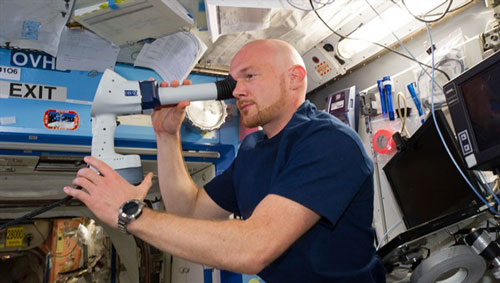| Jun 12, 2014 |
'Guinea pig' in space
|
|
(Nanowerk News) Alexander Gerst has been living and working in microgravity since 29 May 2014, and the focus of his initial research on the International Space Station (ISS) is currently himself. The data acquired upon the start of his mission will form an important baseline for aerospace doctors to observe and analyse changes to the human body that occur in microgravity. This means that, during the first two weeks of his 'Blue Dot' mission, Gerst has been performing measurements on himself, collecting blood and saliva samples and taking ultrasound images of his eyes. For two of the experiments sponsored by the German Aerospace Center (Deutsches Zentrum für Luft- und Raumfahrt; DLR), the German ESA astronaut is also providing data on the condition of his skin and on his core body temperature, which is used to determine his circadian rhythm.
|
 |
| Examining the eyes.
|
|
Gerst is creating a type of 'snapshot' of himself at the start of his six-month mission in space. His body must still adapt to the transition from gravity on Earth to microgravity, and he still has to adapt to life on the ISS. During the first week, US astronaut Reid Wiseman helped him use an ultrasound camera to capture the condition of his eyes for NASA's Ocular Health study. US scientists intend to use this data to investigate the risk posed by microgravity to eyesight and intracranial pressure. Further measurements during the course of the mission and after his return will provide information on possible changes. Gerst has also been asked to provide blood and saliva samples. As part of NASA's Microbiome experiment, these will be used to investigate how microorganisms in and outside an astronaut's body respond to microgravity. In addition, US scientists will use these samples to investigate whether – and how – the immune system of the ISS crewmembers adapts to life in space.
|
|
Skin ageing process in fast-forward
|
|
The astronauts' skin also responds to the new living conditions in space. In 2006, scientists at Witten-Herdecke University in North Rhine-Westphalia, Germany, investigated how astronaut Thomas Reiter's skin changed in microgravity. "On that occasion, we were able to determine that the surface and structure of his skin changed in the same way that it does during the ageing process," explains Nicole Gerlach from the Institute for Experimental Dermatology at Witten-Herdecke University. The skin regenerated itself upon his return from space. "However, a single data set is not adequate for investigating this phenomenon," the project leader stresses.
|
|
For this reason, along with astronauts Luca Parmitano and Steve Swanson, Alexander Gerst is the third astronaut to measure his skin moisture level in space as part of the 'Skin-B' experiment, determining how successfully the skin barrier retains water in the skin and also imaging the surface of his skin at a magnification factor of 20. He performed the same measurements on his forearm before travelling to the ISS, and he will continue to take measurements throughout his mission and following his return. Project Leader Nicole Gerlach and Institute Director Ulrike Heinrich can thus observe how his skin changes under the influence of microgravity over an extended period of time and, by so doing, observe the ageing process over a comparatively short time.
|
|
Shift worker in space
|
|
The astronaut's circadian rhythm is also of interest to scientists on the ground. To this end, Hanns-Christian Gunga from the Charité Berlin medical school is having Alexander Gerst and his colleagues wear dual sensors attached to their foreheads and chests that will measure their core body temperature over a 36-hour period. The 24-hour rhythm of distinct periods of light and darkness experienced on Earth is absent during a long-term mission in space, and the level of physical activity is reduced by microgravity; these changes have an effect on the circadian rhythm and processes throughout the body. For this reason, a total of 12 astronauts are having their core body temperatures measured at regular intervals – before, during and after their missions.
|
|
The data acquired during the circadian rhythm experiment will help to better understand the processes of the autonomic nervous system. This will enable astronauts on the Space Station to plan their work, exercise and leisure activities better. On Earth, the research results will benefit those whose circadian rhythms have been disrupted, causing problems with the autonomic nervous system or sleeping patterns. The dual sensor developed for the astronauts to monitor the surface of the skin has also been used on Earth; the German Heart Institute Berlin has already used the sensors during heart transplants. They are currently being developed for use in neonatal incubators.
|

